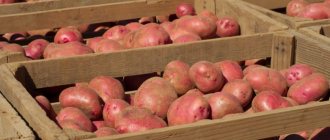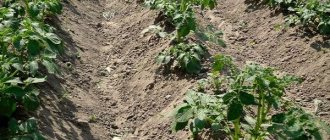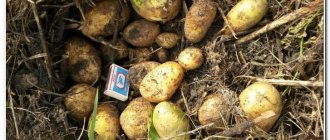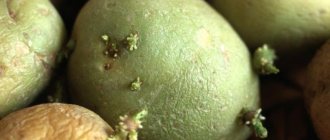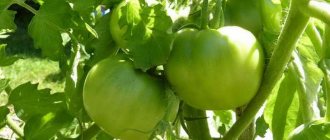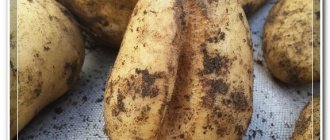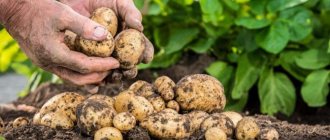Why are there dark spots on potatoes (grey rot)
In the cross-section of some tubers you can see blackening of the pulp. An example of such a change is shown in the photo above. This defect is a sign of gray rot of tubers. It can occur due to a number of reasons. As a rule, they are associated with a violation of the storage or transportation regime of vegetables. Experts identify 6 main reasons why potatoes turn black inside during storage:
Unbalanced soil composition
Many gardeners, in an effort to get a good harvest of vegetables, add large amounts of organic matter to the soil. This can be manure, herbal infusion or green manure. Such fertilizers contain a large amount of nitrogen, which accelerates plant growth and allows you to increase the mass of tubers. However, it is the large amount of nitrogen that is the main reason why potato tubers turn black during storage.
This cause can be eliminated through proper application of fertilizers:
- Fresh organic matter cannot be used for potatoes. It should be well rotted. This applies not only to manure, but also to green manure.
- Adding manure to the soil for growing potatoes is allowed no more than once every 2 years.
Focusing on the use of nitrogen, many gardeners forget about such an important trace element as potassium. But it is potassium that allows the tubers to ripen in a timely manner and be safely stored during the winter. So, to prevent blackening of tubers, it is necessary to regularly add potassium fertilizers to the soil.
Important! The best keeping quality is demonstrated by mature medium-sized potato tubers.
Weather features
Potatoes prefer to grow in conditions with moderate temperature and humidity. Fluctuations in these indicators negatively affect the quality of tubers:
- high temperature leads to overheating of tubers;
- low temperatures slow down the process of nutrient absorption from the soil, resulting in the formation of small vegetables;
- lack of moisture dries out the tubers;
- Excess moisture does not allow potatoes to breathe oxygen to the required extent, as a result of which various fungal and bacterial diseases and rot develop.
Each of these unfavorable conditions and their complex can lead to the fact that potatoes during storage begin to turn black inside and lose their consumer qualities.
Late cleaning
Potatoes must be harvested from the field on time. Every experienced farmer knows this rule. Harvesting an unripe crop and harvesting potatoes with the onset of frost can lead to dire consequences during storage:
- Harvesting must be carried out in accordance with the characteristics of the variety. Harvesting unripe tubers too early will most likely lead to blackening of the potatoes during storage;
- Potatoes must be collected from the fields before the first frost. Temperatures of even -1C can lead to freezing of the crop, as a result of which it will rot during storage;
- In warm sunny weather, potatoes cannot be stored in the soil for a long time after mowing the tops. Without access to moisture, it may overheat;
Timely harvesting of potatoes will reduce the likelihood of black spots appearing inside the fruit during storage by 25%.
Mechanical damage
During harvesting and transportation, potato tubers are often hit, which leads to mechanical damage and bruises. The pulp in deformed areas of the fruit may change color during storage. It is also important to remember that damaged areas of the skin are “gates” for various viruses, fungi, and bacteria, which can also cause putrefactive diseases of root crops.
Important! Potatoes should be stored in small containers in several layers.
Great pressure on the lower layers of the potato can cause black spots to appear inside the fruit.
Storage violation
It is necessary to monitor the temperature in the storage regularly, however, special attention should be paid to this indicator in the fall and spring, when there is a change of seasons. You can regulate the temperature by opening (closing) air vents, ventilation, and placing bottles of cold (hot) water around the perimeter of the room.
You can learn more about all the features of storing potatoes from the video:
Infectious diseases
A disease such as black leg can affect not only the tops, but also potato tubers. Moreover, the first symptoms of infection may appear only during crop storage. A sign of the disease is rot, which quickly spreads from the stolon to the core of the tuber, covering the entire fruit. At the same time, rotting fruits emit an unpleasant characteristic odor. This black rot inside potatoes is different from the usual gray spot. Its peculiarity is its rapid spread within one tuber and infection near nearby vegetables.
It is worth noting that most often potatoes turn black if they contain a large amount of starch. Thus, slightly blackened flesh is the norm for some potato varieties.
Why do potatoes turn dark?
- Growing in soil high in chlorine and low in potassium. Potato growing companies use high chlorine fertilizers to increase potato weight. Chlorine easily enters the pulp of the fruit and, changing the structure from the inside, makes it soft and watery, but large in volume.
- Application of nitrogen fertilizers when growing potatoes. Nitrogen promotes the accumulation of amino acids inside the fruit, in particular tyrosine, which leads to the appearance of spots. When cooked or after cleaning, the stains darken.
- Exposure to low temperatures. After freezing, the structure of the potatoes changes - they become sweet and darken after cooking.
- Shocks during transportation. When potatoes are struck, juice that contains starch is released at the site of impact. The pulp of the fruit thickens and in places where juice is released, when starch reacts with air, the potato turns black.
- Potatoes are poorly prepared for storage. Before placing potatoes in the cellar, they need to be dried, cooled and rotten and spoiled fruits removed.
- Incorrect storage conditions. High humidity and oxygen deficiency in potato storage areas lead to boiled potatoes turning black.
- A potato variety with a high starch content.
Features of care
The root color is black and does not require any special care procedures. Everything is done the same as with ordinary potato varieties.
Watering
Any potato needs timely watering. The future harvest depends on how the moisture supply is carried out. Summer residents advise organizing drip irrigation. But in its absence, water as needed using the usual methods.
The plant requires abundant watering:
- at the moment of budding;
- during the flowering period;
- after it blooms.
Ensuring the supply of moisture will lead to the stated volume of yield.
Top dressing
The plant does not refuse to apply fertilizers. No matter how fertile the land is, fertilizing is mandatory. For the first time, on the 14th day after germination, liquid mullein or urea is used.
The second mandatory feeding is immediately after the potatoes have flowered. Then water with potassium sulfate at the rate of 500 mg per 1 bush.
If there is time and opportunity, the amount of fertilizing is increased.
Weeding
Removing weeds is a mandatory process when growing any crop. This is especially important at the initial stage, when the plant requires the maximum amount of nutrients from the soil. And weeds pull out from the soil most of the minerals that potatoes need for full development.
Another reason to pull out weeds is that they are carriers of diseases and pests.
Loosening the soil
The root system of plants needs a constant supply of oxygen. That's why summer residents loosen their beds. Breaking the crust formed after rain or watering.
Before emergence, the soil is loosened shallowly, this allows the tubers to breathe and develop faster. In addition, it reduces the amount of weeds.
Hilling
Mandatory procedure when growing crops. This protects against the appearance of pests, the development of certain diseases and improves soil aeration. This is done for the first time when the plant reaches 15-20 cm in height. Then 2 more times, until the potatoes finally grow, and this becomes difficult.
Is it worth storing hollow potatoes?
It’s clear that cutting all the potatoes to check their hollowness is not worth it. It is enough if several hollow (to varying degrees) tubers are previously discovered. Then, before storing the crop, it is necessary to separate large tubers.
The selected potatoes must be treated with the drug Fitosporin-M, which is harmless to humans, but does not allow the vegetable to rot due to the Bacillus subtilis it contains. These tubers should be stored separately from others and used for food first. Hollow potatoes are not used as seeds.
Why does it turn black inside?
There are a number of reasons why potatoes can turn black inside - from improper fertilization during cultivation to violation of storage conditions. Blackness can be caused by various diseases that the plant can contract from the soil or from other plants.
Some varieties of potatoes generally do not last long.
They must be eaten in early autumn. If potatoes are over-watered, they may turn brown due to rot. Perhaps the crop was harvested too early, and the tubers did not have time to form a thick enough crust that could protect against diseases.
If growing and harvesting potatoes followed all the rules, then the happy owner of a large amount of high-quality potatoes should be able to preserve them.
- Potatoes require good ventilation and a temperature of +2 ... +6 degrees.
- Before storing tubers, it is recommended to clear them of soil residues to reduce the risk of fungal infection.
- It is better to store the harvest in boxes with gaps between the boards or boxes with holes. It is recommended to install them on pallets to improve ventilation.
IMPORTANT! Regardless of whether the potatoes were washed or the soil was simply mechanically shaken off, they must be placed in storage dry. Sometimes it is recommended to dry it in the sun for some time for additional disinfection by the rays.
Why do potatoes turn black?
There are many reasons for the appearance of blackened pulp inside potatoes and they can all have a different nature of origin. These include:
- the presence of polyphenols and polysaccharides in the vegetable;
- lack of potassium;
- excess phosphorus;
- viral, bacterial and fungal diseases;
- failure to comply with storage conditions.
All of these factors can influence the appearance of dark flesh. But in order to understand in detail the reasons for this phenomenon, it is necessary to consider the type of darkening and at what moment it was noticed.
After cooking
If before heat treatment the potato tubers had a normal appearance, and after cooking the vegetable acquires a uniform bluish or dark tint, there may be several reasons:
- This potato variety contains a large amount of dry matter, in particular starch. They are actively used for making chips: “Red Scarlett”, “Rosara”, “Lady Claire”, “Nadezhda”, etc.;
- When growing potatoes, the soil was poor in potassium or, conversely, there was an excess of phosphorus fertilizers.
In addition to starch, which is a polysaccharide, potatoes contain polyphenols. When interacting with oxygen or under the influence of high temperatures, these substances react, which is also an answer to why boiled potatoes turn black.
The same reaction is observed if the potatoes were grown on soil with a lack of potassium or the producer overdid it with the addition of phosphorus fertilizers.
If there is an excess or deficiency of microelements, the amino acid balance of the plant changes, which ultimately leads to the fact that, due to the chemical reactions that occur, the potatoes turn black when cooked.
During storage
There are also many reasons for the appearance of dark spots during crop storage, but they can all be divided into 3 main groups. The main reasons why potatoes turn black inside during storage include:
- violation of harvesting technology;
- failure to comply with storage conditions;
- presence of diseases.
of harvesting technology include harvesting either too early or too late. When harvested early, young tubers do not have time to form a thick skin, which protects the potatoes from bacteria and pests. Moreover, the tubers do not have time to accumulate substances responsible for protective functions. All this leads to infection of the tubers with various diseases and their blackening.
Late harvesting after frost leads to “frostbite” of vegetables. As a protective reaction, polysaccharides begin to decompose in the tubers, which softens the pulp and leads to blackening - oxidation. The same effect is observed when storage conditions are violated . Potatoes become soft and turn black if:
- if the temperature was below +2 and above +5°C;
- air humidity in the vegetable storage is over 80%;
- there was no ventilation in the cellar.
Another reason why tubers turn black is the storage of damaged vegetables . At first glance, the potatoes may be intact, but during the process of planting or transportation, the tubers often hit each other hard. As a result, the potatoes receive microtraumas, polysaccharides react and the tubers darken.
Another common reason why potatoes turn black inside is the presence of diseases . The spots inside can have different appearances, by which you can identify it:
- black leg - a hollow, black-brown notch is visible on the section of the tuber. Sometimes you might think that this is the activity of some pest, but in fact it is a bacterial disease that is difficult to treat;
- Late blight is a fungal disease. The tubers have a black, uneven color.
Many signs of the presence of a disease in a crop can be noticed even at the growing season: weak tops, brown spots on the leaves, black rot near the roots. Such products will not last until spring, so there is no point in storing them in the cellar.
Related article: Gothic potato tubers (spindle): symptoms, fight
After cleaning
Discoloration after cleaning is a natural phenomenon . It's all about the same polyphenols contained in potatoes. Under normal conditions, substances practically do not interact with each other and oxygen, but everything changes with mechanical damage.
During the cleaning process, the intercellular membranes that separate the substances are destroyed and, as a result, a chemical reaction begins. The same processes occur during heat treatment. It is for this reason that it is recommended to immerse the potatoes in cold water after peeling - this allows you to stop the oxidation reaction.
Landing
There is nothing complicated about planting black potatoes. Even a novice agronomist can handle this. To get a good harvest, it is enough to correctly perform basic agricultural techniques.
Plant black potatoes in shallow holes made with a shovel in loose soil.
Planting of this type of root crops begins in the spring, when the air temperature warms up to +13 C +15 ° C , and the temperature of the soil will not be lower than +7 ° C +10 ° C. A more precise period is determined by the summer resident himself based on the weather conditions of his region.
Seed material
Seed material is prepared according to the usual methods: sorting, greening and germination.
Seed material is selected in advance. Preference is given to healthy medium-sized tubers. A month before planting, the tubers are taken out of storage and “greened,” that is, left in the sun for 8–10 days to accumulate a toxic substance—corned beef. This makes root vegetables unattractive to rodents.
After greening, the potatoes are transferred to a bright room where they are germinated. Before planting, the seed material can be treated against insect pests or the tubers can be soaked in growth stimulants. Potatoes are planted with their sprouts facing up.
Soil selection
To sow potatoes, you need to choose a well-lit, unshaded place.
Ideally, before planting black potatoes, plant the soil with green manure and then dig it up!
The soil on the site is carefully dug up to the depth of the shovel handle . At the same time, organic and mineral fertilizing is applied. For 1 m² of area, 10 kg of compost and wood ash is sufficient. It’s good if green manure previously grew on the site , which is then plowed up along with the soil . But also, depending on the composition of the soil, dolomite flour or a complex of fertilizers can be applied.
The best type of soil for planting black potatoes is chernozem, but loam is also suitable . The depth of the planting holes is 10 cm, the distance between them is 30 cm. If there is possible humidity, the ridge method of planting potatoes is used; at the same depth, the distance between the holes increases to 50 cm.
Prevention of potato hollowness
Before storing, the tubers are dried.
Measures to prevent hollowness:
- Maintaining crop rotation.
- Destruction of plant residues after weeding and tops after harvesting potatoes.
- Timely pre-harvest removal of tops.
- The correct ratio of nutrients - potassium, phosphorus and nitrogen. Avoid excessive application of nitrogen fertilizer.
- On richly fertilized soils, plantings are thickened to reduce the area where plants feed.
- Carefully sorting the potatoes before storing them.
The source of boron is organic fertilizers : pig, horse and cattle manure. Poultry droppings do not contain enough boron.
The proportion of nitrogenous fertilizers should be approximately 1.5 times lower than the doses of phosphorus and potassium.
The average need for mineral fertilizers per 1 hundred square meters is:
- nitrogen – 0.6 kg;
- phosphorus – 0.9 kg;
- potassium – 1-1.2 kg.
Potatoes are planted in well-warmed soil . On heavy soils, tubers are buried to a depth of 5-8 cm, on light soils - 8-12 cm. To prevent the formation of hollows due to temperature changes, they are covered or hilled during return frosts.
To prevent infections, seed potatoes are sprayed with Fitosporin-M with stirring before planting. The consumption rate per 100 kg of tubers is 0.4-0.5 liters of the drug, diluted in 6-7 liters of water.
Before laying, spray with the preparation “Maxim” - 0.2 l / 2 l of water. During storage, potatoes are inspected and affected tubers are discarded.
Preparing the storage:
- thoroughly cleaned of debris and old potatoes;
- before laying, the room is treated with bleach (3%) or copper sulfate solution (5%);
- maintain the temperature at +2…+7°C;
- provide ventilation to reduce relative humidity.
Infectious diseases spread quickly when the humidity in the storage area is high.
The main causes of browning of potatoes (gray spotting)
- 1. Lack of potassium in the soil or excess nitrogen during potato growing. For example, they brought in a lot of fresh manure, mown green grass, buckwheat husks, or dug up the ground with a large harvest of sederats and planted potatoes the same year. Potatoes do not like fresh organic matter because too much nitrogen is released and an abundance of fungi accumulates during its decomposition. As a result, the tubers are affected by scab, and dark spots appear on the pulp during storage. Organic matter is extremely necessary for potatoes, but not fresh but rotted, 1-2 years after application.
- 2. When forming tubers, both lack of moisture and waterlogging are dangerous. If there is a lack of moisture, the tubers overheat in dry, hot soil, and if overmoistened, they suffocate from lack of oxygen.
- 3. Untimely harvesting. Early harvesting of unripe tubers leads to darkening of the pulp. And vice versa, if the potatoes are ripe, the tops naturally dry out or are mowed, and harvesting is delayed, then in warm sunny weather the tubers remain in dry, heated soil for a long time and overheat. Potatoes can spoil if stored in bags for a long time without refrigeration. After excavation, they were not cooled and stored without ventilation. 2-3 months after such harvesting, gray spots appear in the pulp. Potatoes are also “steamed” if, after digging, they are stored for a long time in bags without refrigeration.
- 4. Harvesting too late with the onset of light frosts is dangerous. In cold soil, the tubers become supercooled. and during storage the pulp darkens. It is important to know that at soil temperatures of minus 1.5 - minus 1.7 degrees, tubers freeze and rot during storage as wet rot.
- 5. An important reason for the appearance of gray spotting is bruises and compression of tubers during harvesting, packaging in any container and transportation to their destination.
- 7. A possible reason could be that the selected variety contains too much starch. Such varieties more often suffer from gray spotting.
- 8. Potatoes are often affected by an infectious disease - black leg. The disease is transmitted by infected mother tubers. From a diseased bush we get diseased tubers of varying degrees of damage. The disease continues to develop in the storage facility. The disease is different from gray spotting. The tuber turns black from stalon. The blackness covers the entire heart-shaped part up to the vascular ring, and then the entire tuber rots, emitting an unpleasant smell of rot. During growth, diseased bushes differ from healthy ones. They need to be seen in time, dug up along with the tubers and removed from the field before the main harvest.
Why do tubers turn black during the growing season?
The pulp of root vegetables may darken or become covered with black spots already during the growing season. Gardeners need to know why potatoes turn black in order to prevent unpleasant consequences.
This may be due to a deficiency of minerals, but most often the cause of blackness is infectious diseases. You should always monitor plant tops and take timely preventive measures against pathologies.
Alternaria (dry spotting). Fungal infection. It develops against the background of a deficiency of phosphorus, potassium and nitrates in the soil. Most often it affects potatoes grown in dry and hot climates. Mid-season and late-season crops at risk:
- brown spots appear on the leaves and stems, the tops dry out and disappear;
- the fungus penetrates the tubers and affects the parenchyma;
- black or brown spots appear on the pulp, along the ring;
- the fungus can grow into the parenchyma in the form of fibers;
- These potatoes should not be used for food.
More on the topic: What fertilizing do potatoes need?
Verticillium. The disease develops in dry weather. The fungus appears on leaves and stems. The cause is contaminated soil:
- the lower leaves on the bush turn yellow, curl, and dry out. The top may remain green;
- the fungus penetrates the root crops. Rot develops in the eyes;
- Black spots appear on the pulp, which do not have clear boundaries.
Dry rot. The disease develops against the background of an excess of nitrates in the soil. This happens when adding living organic matter, mullein or bird droppings:
| № | Helpful information |
| 1 | leaves turn yellow, curl, dry out |
| 2 | the stems turn black and wither |
| 3 | the infection enters the parenchyma through cracks or through the eyes |
| 4 | Necrotic areas in the form of dry rot appear on the surface and in the pulp of potatoes |
| 5 | spots are slightly depressed, spread throughout the peel and parenchyma |
Late blight. The infection most often affects potatoes of late varieties. It is necessary to inspect the tops most carefully in August. At this time it is still warm, but night temperatures drop significantly. Air humidity rises. These are favorable conditions for the development of late blight:
- Brown spots appear on the leaves and stems, the tops dry out;
- necrotic areas are noticeable on the peel;
- late blight penetrates into the pulp. Darkened areas appear on it. After a short period of time, the tubers begin to rot.
Potatoes turn black inside if they are infected with any type of scab or cancer. If diseased root crops are found in a garden plot, it is recommended to renew the seed material, remove the top part of the soil from the site, and replace it with new humus.
In other areas of the garden, the soil and plants are treated with Bordeaux mixture, colloidal sulfur, copper sulfate or slaked lime. Similar actions are performed when late blight is detected on potatoes.
What to do to prevent potatoes from turning black
Very often situations arise when potatoes lay in the basement all winter, and by spring they began to turn black. This could be due to poor ventilation.
As the weather gets warmer, the potatoes move into storage and sprout. The pulp darkens and becomes limp. There is a sharp jump in temperature, moisture is released, and the debate continues. Thus, you can lose the entire harvest.
To prevent potatoes from starting to turn black inside during storage, you must follow a number of rules:
- After harvesting, potatoes should be placed in the fresh air for 20 days;
- place it in wooden boxes equipped with ventilation holes;
- maintain the required temperature in the storage;
- boxes and pallets should be moved 20 cm away from the walls;
- potatoes are sorted at least once - sprouted and diseased tubers are removed, as well as healthy ones located next to them;
- if storage is carried out at home on the balcony, then it is recommended to cover the boxes with a warm blanket;
- Potatoes can only be stored together with beets, which will take away excess moisture from them; proximity to other vegetables is strictly prohibited.
If you follow these recommendations, the potatoes will last almost until spring, and the efforts to grow them will not be in vain.
What is tuber hollowness and what does affected potatoes look like?
It happens that when a large tuber is cut, a hole is discovered. This phenomenon is called hollowness (by analogy with the hollow of a tree). It is found in varieties that bear fruit with large tubers, such as Lyubimets, Gatchinsky, Temp, Stolovy 19, etc.
The only negative, however, is important - sometimes about half of the tuber is cut out, and this is a loss. Therefore, it is useful to know the methods of preserving the harvest, which we will try to help with.
Is it possible to eat darkened potatoes?
Potatoes that have changed color during heat treatment are considered quite suitable for consumption, since blackness is not a sign of a high concentration of nitrates or other dangerous substances in the vegetable pulp. The product loses only its aesthetic and taste qualities, and these factors cannot cause harm to health.
Before deciding to eat blackened potatoes, you should understand the reasons. If we are talking about cooking greened tubers, then it is better to refuse such a dish. Peeling the peel does not rid the vegetable of the solanine accumulated in it. The highest concentration of the toxic substance is located around the circumference of the potato in a centimeter layer.
What to do if the potatoes become hollow
If you find hollows in the tubers in the harvest stocks, you can safely eat them, since they are harmless to the human body (with the exception of hollowness with rot). However, to avoid these unprofitable problems in the future, be sure to study the correct technology for growing such a wonderful vegetable.
Hollow potatoes are not harmful to people, but they bring losses and deprive the gardener of joy as he awaits the harvest. The main measure to combat this phenomenon is prevention, which implies compliance with all the rules of agricultural technology for growing crops.
If you find an error, please select a piece of text and press Ctrl+Enter.
Reasons why potatoes turn dark
There are several factors that provoke darkening of color after heat treatment of root vegetables. In addition, the reasons are not always related to errors in cooking technology. Most of them are allowed during the process of growing and storing potatoes.
- Potassium deficiency in the soil where the tubers grow. It is recommended to use high-quality fertilizers produced by a trusted manufacturer.
- High chlorine content in the soil. The chemical penetrates the pulp, changing the structure of the vegetable. As a result, the root crop is large in volume, but watery and soft.
- Excessive use of nitrogen fertilizers. The active substance promotes the accumulation of amino acids (including tyrosine) inside the pulp, which provokes the formation of spots.
- Inaccurate harvesting. When a vegetable is struck or transported harshly, its structure is disrupted. The result is blackening of the deformed areas after cleaning or cooking.
- Violation of the temperature regime during potato storage. Indicators below +1° are considered dangerous for root crops. A frozen vegetable loses its color even after cleaning.
- Loading potatoes immediately after digging into storage. The harvested crop must first dry well, after which it is sent to a cool place for gradual cooling. Only when frost occurs is the workpiece transferred for wintering to cellars or other specially equipped rooms.
- Lack of oxygen in winter storage. The problem is solved by installing a ventilation system.
- High humidity in the cellar or other storage for vegetables. In a humid environment, mold actively develops, which destroys oxygen. Periodically, it is necessary to carry out an inspection of the cellar in order to eliminate any problems that have arisen. Wet tubers need to be dried well, separating them from the general harvest.
Can it be eaten?
If the potatoes have turned black, this does not mean that they have become less healthy and cannot be cooked. Often this is a natural process or minor disturbances during transportation or storage. These reasons do not cause any harm to the human body.
However, if the potatoes have darkened as a result of the development of a bacterial or fungal disease, it is better to discard the product. During their life processes, microorganisms release toxins that are not destroyed even after heat treatment.
How to properly cook potatoes so they don't darken
To prevent potatoes from changing color during cooking, you should thoroughly peel the vegetable. To begin with, you should thoroughly wash the tubers, so that dirt and residues of chemical fertilizers do not get on the pulp. You need to peel until the pulp is light, leaving no greens or traces of peel.
Immediately after peeling, the potatoes are stored in a container with cool water. Lack of contact with oxygen inhibits physical and chemical processes. Before cooking, the workpiece is washed well again under running water.
Reference! Ignoring sanitation standards when preparing potatoes for cooking provokes not only a decrease in the aesthetic and taste qualities of the vegetable. Remaining chemical particles pose a health hazard.
In the process of preparing root vegetables for cooking and directly during heat treatment, it is important to ensure that the potatoes are completely immersed in water. If the workpiece is not immediately placed on the fire, then the water in which the potatoes settled must be replaced.
Experienced chefs add bay leaves to the pan when cooking. This trick helps prevent black spots from appearing on the flesh.
Methods for storing peeled potatoes
Sometimes housewives have to put peeled potatoes aside for a while until the next time they are cooked. To prevent it from darkening and retain its taste, you should follow some rules:
- Storing peeled potatoes in the refrigerator involves using a chamber with a temperature of 0 to 6 degrees. If you know how to properly preserve a vegetable the next day, you can use peeled potatoes even a day later. It is completely placed in water in advance and covered with a lid, and rinsed well before cooking.
- Sulfated potatoes, packaged in containers, are stored for 24 hours at a temperature of 15 degrees. It is washed thoroughly before cooking to get rid of the chemicals that coat it.
- Like other vegetables, store peeled potatoes in a plastic container, covered with a damp, clean cloth. Leave the potatoes in this form for a maximum of 12 hours.
If, 24 hours after storing the vegetable in the refrigerator, it is not useful, leave it for another day and be sure to change the water.
Errors during the growing period
Darkening of the tuber pulp may be evidence of improper cultivation of the crop. When growing potatoes, gardeners often make the following mistakes:
- The soil is not fertilized correctly. Excessive application of nitrogen fertilizers and lack of potassium fertilizers leads to potato diseases, including dark spots on its pulp. Often a lot of fresh manure, grass clippings, green manure and buckwheat husks are added to the potato plot, and then they are immediately dug up for planting. This cannot be done - the harvest will be of poor quality, and the bushes will be infected by fungi. Within a month after placing the potatoes in storage, you may notice gray spots on their flesh. You should not plant an area with root crops immediately after applying organic fertilizers. Skip one season. It is best to first let organic fertilizers rot for 1-2 years, and only then distribute them throughout the garden.
- The second reason leading to crop damage is improper watering. During the formation of tubers, it should be moderate. An excess of moisture leads to a lack of oxygen in the soil, and with a lack of it, the tubers overheat. With any of these options, the shelf life of the crop will be reduced.
Special attention should be paid to potato varieties that contain a lot of starch; they suffer from gray spots more often than others.
Reasons for the appearance of emptiness
This disease of potato tubers occurs due to cultivation in unsuitable conditions, as well as incorrect use of fertilizers, when little of some is applied and a lot of others.
Just hollowness
Most often, the reason for the formation of hollowness in potatoes is the rapid growth of the upper layer of the tuber in relation to the inner one. This happens for several reasons:
- crop growth on sandy soil in a hot climate;
- excessive watering of the planting or too long a period of rain;
- bushes planted at a great distance from each other;
- too deep planting of seedling tubers;
- unbalanced nutrition with fertilizers especially contributes to too intense weight gain and an excess of nitrogen.
A kind of competition occurs, the deeper tissues do not keep up with the outer ones, a rupture occurs inside and a void is formed. Holiness is provoked by all types of stimulation of rapid growth.
The voids have different shapes - cross-shaped, oval, round, etc., as well as unequal sizes. Most often, in spherical tubers the hollowness is elongated, while in oblong tubers, on the contrary, it is spherical. The cavity has brown or cream colored walls. In most cases, this defeat occurs on large tubers. But there are also exceptions.
Hollowness with blackening
It happens that the blackness of the potato tissue is added to the hollowness. One of the reasons may be the same as the provocation of voids - too much nitrogen in the soil (excess of nitrogen fertilizers or lack of potassium).
Potatoes can also turn black inside due to watering errors. This result is possible both in case of lack of water and in case of overflow. Undiluted organic fertilizers can also cause blackness, since concentrated products are unsuitable for crops.
Blackness often appears on the pulp of potatoes during storage. Dark spots appear when potatoes are left in an unventilated, warm place for a long time, about two months. Potato supplies must be kept in a cool, ventilated room, optimally plus 1-3 degrees. At lower temperatures the vegetable will freeze.
Related article: Potato cancer: symptoms of the disease, methods of prevention and control
Varieties with a high starch content are susceptible to blackness. Darkening appears when such a vegetable is cooked. Such potatoes are quite suitable for eating, that is, they are not dangerous. Unpleasant “aesthetic” sensations from dark potatoes in a plate can be avoided by adding vinegar or citric acid to the water when cooking.
Why are potatoes empty and brown?
In potatoes with a void inside, beige, brown or brown spots are formed mainly due to improper storage. Most often these are various types of rot.
There is also such a lesion as glandular spotting. It is noticeable on the cut of the vegetable - these are brownish or red-brown spots, different in size and shape. These signs are not visible from the outside. The reason is a disruption of chemical processes in the plant.
Why do potatoes turn black inside?
Potatoes are a very popular vegetable in Russia; almost every gardener grows them. But it is important not only to get a large harvest, but also to preserve it. The most common problem in this case is that the tubers turn black inside. Sometimes even normal-looking vegetables have dark spots in their cut.
Important! Medium-sized mature tubers last the longest.
It is necessary to promptly identify the reason why the tubers begin to turn black inside during storage and eliminate it, otherwise the entire crop may be destroyed. Such signs can be caused by both the physiological disease melanosis, or gray spotting, and various infectious diseases caused by fungi.
Adverse weather conditions
Potatoes grow well in moderate humidity and temperature. If these indicators change, this negatively affects the yield and keeping quality of tubers:
- at high temperatures the vegetable overheats;
- at low temperatures, potatoes grow small due to lack of nutrients;
- if there is a lack of watering, the crop dries out;
- If there is an excess of moisture, oxygen does not reach the tubers well, provoking the development of bacterial and fungal infections.
All these conditions, individually or in combination, can lead to the vegetable starting to turn black inside. Thus, the product loses its consumer qualities.
Incorrect application of fertilizers
Some gardeners, in pursuit of large yields, fertilize their vegetable crops with too much organic matter. Herbal infusions, manure or green manure are used. These fertilizers promote plant growth due to their high nitrogen content. But during storage, such overfed tubers begin to turn black inside.
To avoid spoilage of potatoes after harvesting, you need to fertilize them according to the rules:
- fresh organic fertilizers are not used, only rotted ones;
- manure is applied rarely - once every 2 years.
There is often an excess of nitrogen and a lack of potassium fertilizers in the soil. Namely, potassium is what contributes to the long-term storage of potatoes. Without it, it may begin to turn black.
Mechanical damage to tubers
Potatoes can also turn black inside due to mechanical damage that occurs during harvesting or transportation. Deformed parts of the potato subsequently change color. And if the skin is damaged, then there is a high risk of fungi and bacteria entering the vegetable.
Potatoes turn black inside during storage also when they are placed in several layers. The tubers lying below experience quite a lot of pressure.
Infectious diseases
The appearance of characteristic dark spots inside tubers is usually accompanied by diseases such as:
- Blackleg. A disease called blackleg affects potato tops and tubers. Its first symptoms appear during crop storage. It is rot that reaches inside the center of the tubers, and they begin to turn black. Externally it can be distinguished from gray spotting. The entire fruit is affected, beginning to emit an unpleasant odor. Potatoes lying nearby are also susceptible to infection. It is important to identify the disease at the growing stage in order to prevent such vegetables from entering storage.
- Late blight. The disease is common in almost any climate where potatoes are grown. Both tops and tubers are affected. The fungus spreads quickly, harming all plants. Brown spots appear on the leaves, they rot and dry out. The disease is transmitted through weeds and progresses when agricultural practices for potato cultivation are violated. Tubers affected by late blight become covered with brown spots on the inside. High temperature promotes the development of fungus. Potatoes become infected during harvest or from their own diseased tops. The likelihood of transmission from a neighboring tuber during storage is minimal. Late blight can also provoke diseases by other fungi.
Improper storage
The potato harvest is stored in a basement at a temperature of +1 to +4 °C. If the indicator drops below, the tubers become sweet and begin to turn black inside. At higher temperatures, potatoes germinate and the risk of gray rot increases.
Late cleaning
Timely harvesting of potatoes is the key to preserving the resulting harvest. To prevent the tubers from starting to turn black inside, adhere to the following rules:
- When harvesting potatoes, you must be guided by varietal characteristics - a crop harvested too early will most likely turn black inside during storage. Tubers must ripen in natural conditions.
- Harvesting must be done before the first frost. If you leave potatoes in the ground at a temperature of -1 ° C, they will freeze and then rot during storage.
- After the tops have been mowed, the tubers must be collected as soon as possible. If warm weather begins, the vegetable may overheat.
- The collected potatoes are stored in a dry, well-ventilated room at a temperature within +4 °C.
Harvesting potatoes in a timely manner reduces the likelihood that the tubers will begin to turn black inside during storage.
Blackening due to crop diseases
As mentioned earlier, the appearance of dark spots can be caused by one or another disease, let’s find out why potatoes can turn black inside, what diseases contribute to this:
Blackleg
This is an infectious disease that is transmitted from an infected tuber to a healthy one. Moreover, further spread of the disease can occur in the bags, when the potato crop has already been harvested and the fields are empty. Externally, this condition can be distinguished from gray spotting, because from the inside the tuber will turn black from the stalon. Black spots initially cover the middle of the potato, later moving to the vascular branches, appearing on the peel. Also a distinctive characteristic of the disease is a characteristic unpleasant putrefactive odor. It is important to detect the problem early during the growing stage to prevent the spread of the disease.
Melanosis
Next we will talk about a disease such as melanosis. Externally, the tuber and peel of the affected crop will look normal, without changes, but at this moment the blackness continues to increase under the peel. It is worth saying that the affected vegetables remain suitable for food, which cannot be said about the previous disease - blackleg. To ensure that the stains do not increase in size and the prepared dish looks more or less attractive and appetizing, you need to add vinegar and citric acid to the water during cooking; it is not necessary to peel the peel.
The reasons for the appearance of melanotic spots can be different, for example, mechanical damage to the vegetable.
Potato varieties with a high starch content in the pulp most often suffer from melanosis; it becomes dark more often than others. In addition, the development of the disease is accompanied by errors in choosing the harvest time. It is worth taking this aspect wisely, and also doing everything to avoid injuring the tubers during harvesting.
The cause of the disease can be high humidity
An excellent prevention of melanosis is placing beets in potato bags; it helps keep the potato pulp intact. The fact is that beet will help overcome the problem of excessive humidity in the place where tubers are stored.
Late blight
Another reason for the appearance of such spots on the pulp may be late blight. This disease occurs in any region, including the entire territory of Russia. A distinctive feature of the disease is that it affects not only the tuber, but the leaves of the plant. This fact greatly complicates pest control. If preventive measures are not taken in time, there is a possibility that the fungus can infect all plants and crops growing in the garden or field.
Signs of late blight
- Brownish spots and dots form on the leaves
- The leaves rot and then dry out
- The final stage is their fall
Causes of late blight
Infection with late blight occurs as follows and for the following reasons:
- Remains of weeds and other vegetation were not removed in time
- The seedlings were initially infected with a fungus
- Mistakes were made in the technology of growing potatoes.
It is worth saying that the scale of late blight damage is impressive; the disease spreads very quickly. The peak incidence occurs during the flowering period of the bush, although in most cases the period of infection can shift in one direction or another depending on weather conditions. The most favorable time for the reproduction and spread of the fungus is wet and damp weather - rainy autumn or thaw in spring. In addition, the spread of infection will be facilitated by excessive watering of potato bushes, thus, pathogenic microflora will move along with moisture through the soil. It is worth saying that, despite the fact that late blight itself poses a danger to the future harvest, the disease also significantly increases the chances of infection with other ailments, for example, various fungal diseases or wet rot.
Prevention of late blight
In order to preserve and protect your crop from late blight, you need to know all the preventive measures, because they are quite simple, in contrast to getting rid of the disease, which involves getting rid of infected bushes. We will try to list the main preventive measures that every farmer should know:
- Do not cover the harvested potatoes with tops. If there are infected leaves, there is a risk that the disease will soon spread to the tubers
- Harvest depending on the potato variety. So, earlier varieties should be dug up earlier, without waiting for the thickness of the peel, while later varieties should be dug up later.
- Follow watering norms and do not forget to add fertilizers to the soil on time.
What to do to prevent potatoes from browning
Experts and experienced gardeners advise adhering to the following rules, which will prevent the root crop from changing color during the cooking process.
Choosing the right potatoes
When purchasing, it is important to carefully examine and feel the tubers. They should be firm with no signs of damage. Potatoes should be discarded if they have dents, cuts, or rotten formations. Low quality is also indicated by compressed skin and sprouted eyes. If you buy vegetables in bags for home preparation, then you should look inside them to check the dryness of the potatoes.
The appearance of dark spots after heat treatment of a vegetable can be caused by the high starch content in the pulp. When making a purchase, you should be interested in the name of the variety. Potato varieties that have a starchy texture should be avoided.
Reference! Root crops with a high starch content are classified as fodder crops. Among them: Minerva, Lorch, Voltman, Korenevsky, etc. You should not purchase such vegetables for cooking.
Fertilizer
When growing root crops yourself, it is important to monitor the composition of the fertilizers used. Preference is given to potassium-containing fertilizers. Do not overdo it with nitrogen fertilizers and chloride nutrients for the soil.
When feeding the soil with organic matter, you need to take into account that it also contains nitrogen and chlorine. Therefore, you should not violate the recommended consumption rates per 1 m2. All fertilizing is applied according to the schedule developed by agronomists for certain crops.
Storage
The harvested crop is laid out in the fresh air or under a canopy to dry. It is important that the sun's rays do not fall on the potatoes, otherwise they will quickly turn green.
Dried tubers are stored in a cool place until cold weather sets in. Further storage is carried out in a prepared winter hut (cellar, basement and other specially equipped premises). It is systematically required to control the following microclimate indicators: humidity (moderate), temperature (within 1-8°), oxygen flow (natural or forced ventilation).
How to avoid browning of potatoes
What should I do to ensure that in any situation (cooking, storage) the potatoes do not turn black and lose their taste? Let's start with the fact that it is necessary to follow the rules of agricultural technology.
Recommendations for growing potatoes
It is recommended to grow different potatoes on the site:
- early-ripening and mid-ripening (in the south they add late-ripening, which manages to ripen before the onset of cold weather);
- with high and medium starch content (the first is suitable for purees, baking, making chips, pancakes, the second - for soups, frying, salads).
It is advisable to select zoned varieties that are resistant to infections and are less susceptible to attacks by pests. Further:
- maintain the timing of planting and harvesting crops, taking into account the weather and climate of the area;
- comply with fertilizer application standards without overusing nitrogen;
- during dry seasons, provide regular irrigation to the plantings;
- exclude chlorine from fertilizing;
- be sure to carry out preventive treatments against diseases and insect attacks;
- alternate crops on the site;
- use healthy seed material for planting.
Rules for storing vegetables
After digging, carefully dry the potatoes in the open air or under a canopy, sort them, removing diseased and damaged tubers.
On a note! Be sure to burn infected tops and tubers without using them for composting.
Seeds and potatoes for food are stored separately, regularly checking the supply of vegetables. In the cellar, a comfortable regime for tuber crops is provided:
- humidity – 80-85%
- air temperature: +3ºC…+5ºC.
Store the tubers in the dark. They are distributed according to shelf life: early potatoes are eaten in summer and autumn, mid-season and late potatoes are used for food in winter and spring. The storage facility must be disinfected and storage containers (bags, nets, chests, wooden lattice boxes) must be prepared in advance. When stored in bulk, the layer of tubers should not exceed 80-100 cm.
Infected potatoes cannot be stored. It is discarded and burned. Beets are suitable as “neighbors” in the cellar for potatoes; it is advisable to separate other vegetables.
Useful tips for housewives
The very first thing: before cooking, potatoes must be washed in running water, removing dirt and possible chemical residues from the skin (especially from store-bought vegetables). To prevent the potatoes from turning black after peeling, they are immersed in cold water. For high-starch varieties, a couple of drops of citric acid will serve as a preservative; water will remove excess starch from the surface of the vegetable.
Before adding to soup or cooking, the water in which the potatoes were is drained. When cooking a vegetable, the liquid must completely cover the potatoes, otherwise a grayish coating will appear on the upper parts. Instead of citric acid, you can add bay leaf to the water; it also protects the pulp from blackening.
When boiling potatoes in their jackets, wash the tubers thoroughly with a brush, then place them in a saucepan and fill completely with cold water. Add a teaspoon of salt, cover with a lid and bring to a boil. Then reduce the temperature and cook over low heat until tender. It is tastier to bake a vegetable in its jacket in the oven, then more vitamins and nutrients are retained in the pulp.
We hope that the information about why potatoes turn black in different situations will be useful. Follow simple techniques and rules, take into account the characteristics of the varieties - and you will never have problems with storing and preparing this tasty vegetable.
Natalia Severova
Features of agricultural technology
The agricultural technology of black potatoes is not much different from ordinary ones. Timely watering is very important, because the future yield of the variety depends on it.
Whatever the care, such will be the harvest.
Potatoes should be watered during the following periods:
- budding;
- flowering;
- after flowering.
Watering is done at the root. It’s good if you can organize drip irrigation, but you can moisten the soil in the traditional way.
Top dressing
The first application of fertilizers to potato rows is made when small bushes are formed.
- When planting , you can add wood ash to each hole.
- The second feeding is done after 2 weeks. For this, urea or mullein solution is used.
- The third fertilization of the soil is carried out immediately after flowering. To do this, potatoes are spilled with a solution of potassium sulfate (500 mg per bush). Depending on the “poorness” of the soil, the amount of fertilizing can be increased.
Weeding
The first weeding is carried out as weeds appear, usually combined with hilling.
And also don’t forget about regular weeding.
Weeds draw large amounts of nutrients from the soil, so crops are often delayed in growth and development due to deficiency.
In addition, weeds are the habitat of many pests that can spread to potato crops.
General rules for peeled potatoes
You should remember the recommendations that will help keep peeled potatoes in their original form, and also help avoid darkening of the tubers:
- Do not cut the potatoes too finely, otherwise they will lose their beneficial properties.
- After cleaning, each of the tubers is washed and placed in water so that dark spots do not appear on them.
- If gas bubbles appear in the water, the potatoes have gone bad.
- Before freezing, potatoes are blanched so that they do not darken after peeling.
- When storing a vegetable, take into account its proximity to other products. Close proximity to smoked fish causes a spoiled dish, because the potatoes will become saturated with the smell. It is also not recommended to store meat next to vegetables.
Thus, the root vegetables are stored in the refrigerator until the morning, covered with water. They are frozen for several days. The potatoes are left whole or cut depending on the dish they will be used in. Although the procurement procedure takes some time, it allows you to save it in the future.
